A unique 70mm vertical film installation created for the “Man the Explorer” pavilion at Montreal’s Universal Exposition, Expo 67.
Film Explorer
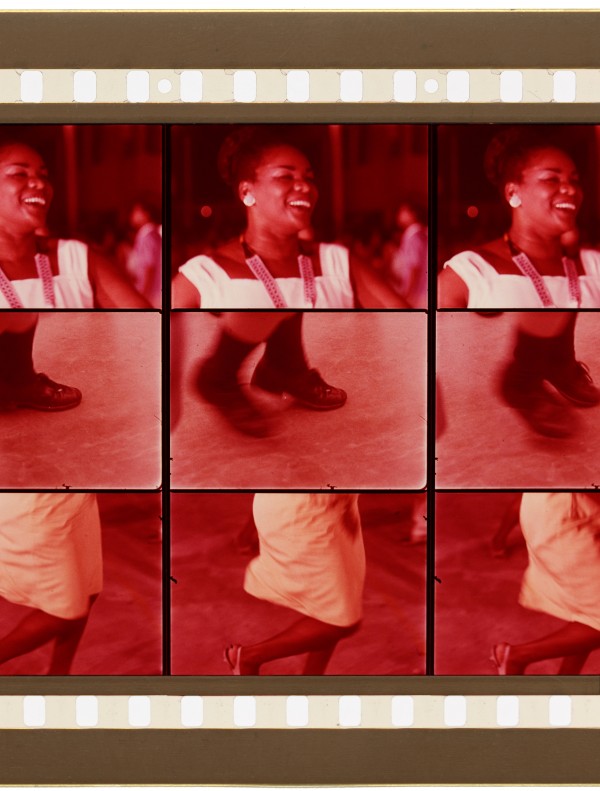
A 70mm print, with magnetic stripe soundtracks, of The Earth is Man’s Home (1967), showing three frames within the standard 70mm frame area, in a horizontal orientation. Colour fading is evident.
La Cinémathèque québécoise, Montréal, Canada.
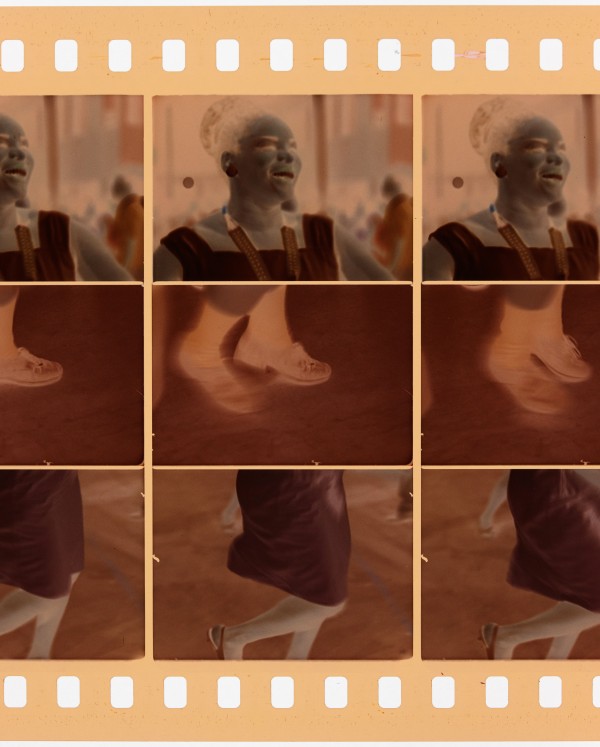
65mm internegative, demonstrating the optical printing of three 35mm frames within the 65mm frame in a horizontal orientation, The Earth is Man’s Home (1967).
La Cinémathèque québécoise, Montréal, Canada.
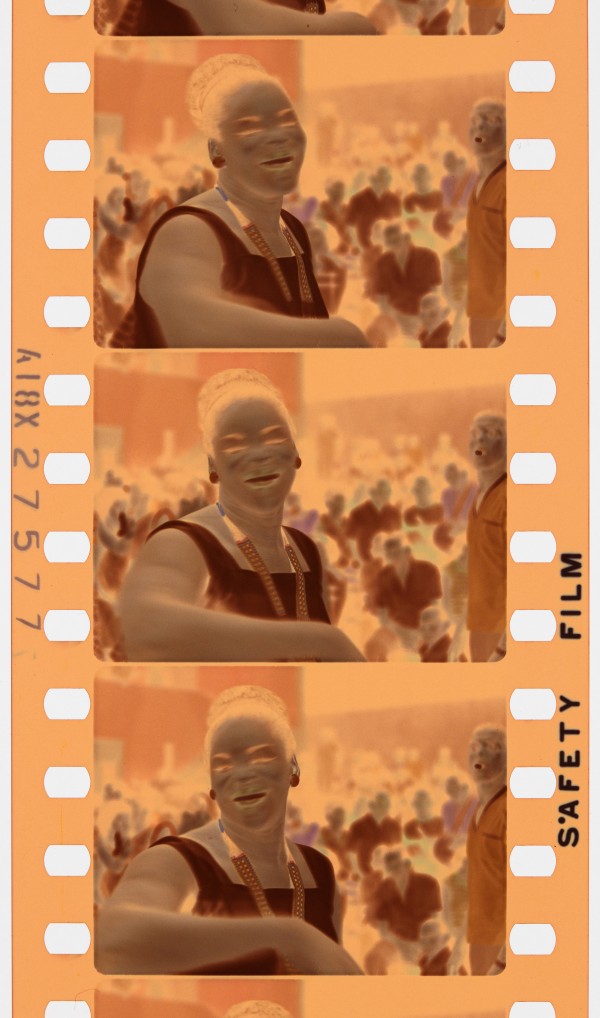
35mm camera negative. Much of The Earth is Man’s Home’s source footage was shot on 35mm full-aperture camera negative and reformatted, for printing to 70mm prints, on a 65mm internegative.
La Cinémathèque québécoise, Montréal, Canada.
Identification
23.9mm x 49.3mm (0.941 in x 1.941 in); individual frames, 23.9mm x 16.6mm (0.941 in x 0.654 in).
(image rotated 90 degrees with mirror during projection)
Eastman Color.
Standard Eastman Kodak edge markings.
1
Surviving prints, held by the Cinémathèque québécoise, Montréal, suffer from colour fading.
Only channels 2, 3 & 4 of the 70mm 6-track magnetic stripe were used.
Footage shot independently on 35mm, stock footage on 16mm and still photographs, were optically printed onto 65mm intermediate negative stock in order to make 70mm prints.
24.9mm x 18.7mm (0.980 in x 0.736 in)(35mm, full-aperture); 10.26mm x 7.49mm (0.404 in x 0.295 in) (16mm).
Bell and Howell (BH) (35mm camera negative); Kodak Standard (KS) (65mm internegative).
Eastman Color and B/W negative, colour internegative.
Standard Eastman Kodak edge markings.
History
The Earth is Man’s Home was a unique, vertical (portrait-oriented) film installation created for Montreal’s Universal Exposition, Expo 67, in the “Man the Explorer” theme pavilion (within the “Man, His Planet and Space” subsection). It was one of thousands of films (16mm and 35mm, as well as numerous experimental multiscreen and large-format films) that were screened during the six-month event across the almost 100 national, commercial and private pavilions. The 11-minute, 70mm film was projected on a vertically oriented screen, 30-ft tall x 13-ft wide (9.14m x 3.96m), in a “triple theatre” (three auditoriums side-by-side, each seating 150 viewers). Co-director Nick Chaparos described it as “[a] CinemaScope-type screen turned on its side, but with the picture right side up” (Chaparos, 1967: p. 570).
The film was produced, directed and edited by American filmmaker/designer husband-and-wife team, Nick and Ann Chaparos, who originally developed the concept for the project in 1965, for the Institute of Design, University of Waterloo, Ontario, through their company Chaparos Productions Limited (Linwood Dunn Archives; Chaparos, 1967: p. 590). The film was originally shot in 35mm colour and B/W, and integrated with found-footage (including 16mm) and still photographs, amounting to approximately 500 images in all. The storyline was composed – after shooting on the film had concluded – by the then-notable author of popular Canadian TV series Wojeck (1966–8), Phillip Hersch. The script focused on the entangled relationship between humankind and the environment, highlighting the complexity, beauty and fragility of the planet. The final screen-format comprised three distinct, contrasting images, stacked vertically within a single 70mm frame; alternatively, the three images could be harmonized to create a single, monumental image – of subjects such as a newborn baby, a rocket launch, or an atomic-bomb explosion. The visuals were accompanied by a lively soundtrack of voices, music, and ambient sounds recorded in the wild, and subsequently incorporated by the sound technician, Brian Avery. Songs included: “Yellow Bird”, performed by Jeanne d’arc de Sampaio in Brazil; “Dominique”, performed by Soeur Sourire (the Belgian singing nun); and “The Wanderers”.
Chaparos gives a detailed account of the production, filming and sound recording – at locations in Canada, Peru, Brazil, England, France and the US – in a 1967 American Cinematographer article. He estimated that three-quarters of the film was shot solely by a three-person crew, consisting of himself, Anne Chaparos, and sound technician Brian Avery. Great attention had to be given to multi-frame image composition, in addition to post-production and film editing – all the time with an eye to the eventual impact on viewers. Despite considering the possibility of including many more frames within the master frame, the team decided to restrict themselves to three, so as not to overwhelm the spectator. Indeed, the first few minutes of the film were purposefully designed to be a graduated “eye exercise”, with the aim of training the viewers’ eyes, ensuring “maximum perception” and “maximum informational impact”. The main storyline was generally situated in the middle screen, with subsidiary elements placed above and below; the use of the full vertical screen had the effect of creating a so-called “dead center” (Chaparos, 1967: pp. 587–8). The film stands as a wonderful example of a particularly 1960’s strand of humanist environmentalist filmmaking, which still resonates today. Other Expo 67 multi-screen films, such as Labyrinth and Polar Life, demonstrated a similar restraint, as well as a remarkable understanding of the spectatorial experience of these experimental viewing formats. Writing in one of the more extended critical accounts of the film, in the Journal of the SMPTE in 1968, composer Frank Lewin effusively described The Earth is Man’s Home as “one of the most moving films ever produced” (Lewin, 1968: p. 200).
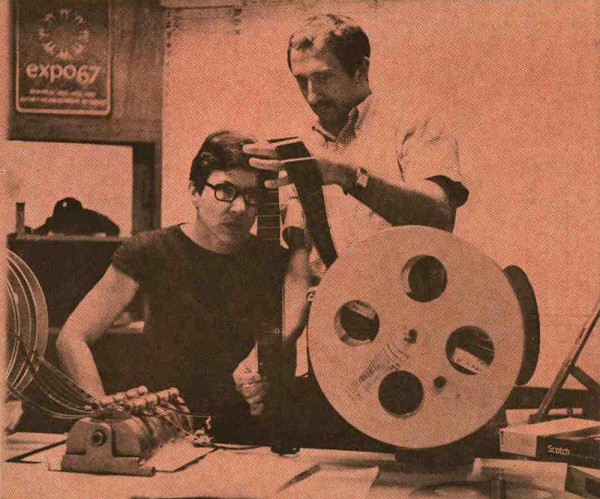
The Earth is Man’s Home filmmakers Nick and Ann Chaparos.
Chaparos, Nick (1967). “Producing and Filming The Earth is Man’s Home”. American Cinematographer, Special Issue on Expo 67 (August): p. 571.
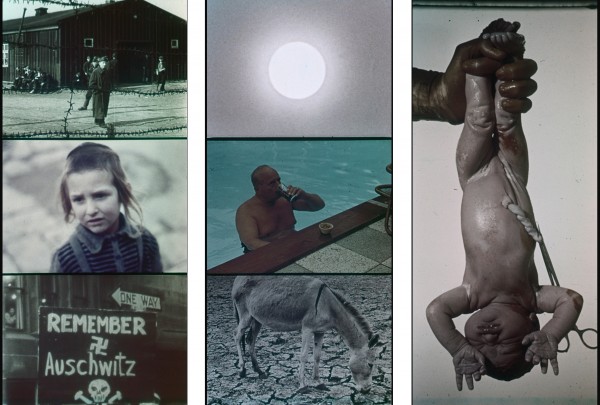
Frames from a digitized and colour-corrected 70mm print of The Earth is Man’s Home (1967), prepared by Fotokem and EndPoint Audio for the Cinémathèque québécoise, demonstrating the use of three independent vertically stacked sub-frames, and a single extended image within the same screen area.
La Cinémathèque québécoise, Montréal, Canada.
Selected Filmography
11 minutes. Created for, and screened at, the “Man the Explorer” theme pavilion (in the “Man, His Planet and Space” subsection), Montreal’s Universal Exposition, Expo 67.
11 minutes. Created for, and screened at, the “Man the Explorer” theme pavilion (in the “Man, His Planet and Space” subsection), Montreal’s Universal Exposition, Expo 67.
Technology
Shooting for The Earth is Man’s Home was conducted with three 35mm motion-picture cameras: a Mitchell S35R (Mark II) Reflex, an Arriflex, and an Eyemo equipped with a fisheye lens (Chaparos, 1967: pp. 588–9). The Mitchell was used with a 25mm to 250mm zoom lens, as well as standard lenses ranging between 25mm and 90mm (Chaparos, 1967: p. 589). Both the Mitchell and Arriflex cameras were modified to shoot with a non-standard, larger full-aperture frame. All original location sound was recorded using a Nagra Model III recorder (Chaparos, 1967: p. 589).
The Earth is Man’s Home involved the combining of several different film formats and processes, which were eventually projected onto a unique 30-ft high, 13-ft-wide (9.14m x 3.96m) screen. The 70mm frame was projected vertically. Original 35mm footage was combined with 16mm stock-footage (blown-up to 35mm), and was edited into the “three frame” vertical composition using three Simplex 35mm portable projectors, electrically synchronized. The magnetic head of a Moviola was used for reproducing the sound (Chaparos, 1967: p. 587). Subsequently, this three-strip edit was optically printed as a vertical column by Film Effects of Hollywood onto 65mm Eastman Color negative film at 90 degrees to the conventional orientation (Love, 1967: p. 593). From the 65mm negative, 70mm release prints were then produced by Technicolor. Only three of the 70mm print’s standard six magnetic stripe audio channels were used: tracks 2, 3 and 4 (Bergh, 2017). The audio was first mixed by Joe Grimaldi at Pathe-Humphries (Chaparos, 1967: p. 571) and then re-recorded by Fred Hynes at Todd-AO (Chaparos, 1967: p. 587).
Unlike the IMAX format – which similarly has the frame oriented at 90 degrees to the conventional direction, and which then accordingly feeds film horizontally through the projector – The Earth is Man’s Home was fed vertically through its projectors, with a prism rotating the image through 90 degrees to fit the vertical-format screen (Love, 1967: p. 593). To accommodate the through-put of audiences anticipated for a Universal Exposition, the film was screened in three theaters, arranged side-by-side, at six-minute staggered intervals (Churchill, 1967). The theaters themselves featured the vertical-format screen inclined towards the auditorium, with 150 tilted seats mounted on shallow-raked risers below, to minimize neck strain (Love, 1967: p. 593). Given that the final 70mm film strip only makes use of three of its six available audio tracks, the verticality of the screens used to exhibit the film, and the fact that the musical soundtrack is recorded in mono, while sound effects are in stereo, it is highly likely that the three audio tracks used represent distribution in the upper, middle and lower speakers, rather than a conventional left, center, right configuration (Bergh, 2017).
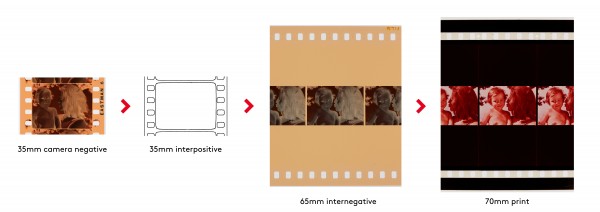
Original production elements for Earth is Man's Home (1967). The film was largely shot on 35mm color negative, which was then reformatted into three stacked images rotated 90 degrees onto 65mm/70mm film.
La Cinémathèque québécoise, Montréal, Canada.
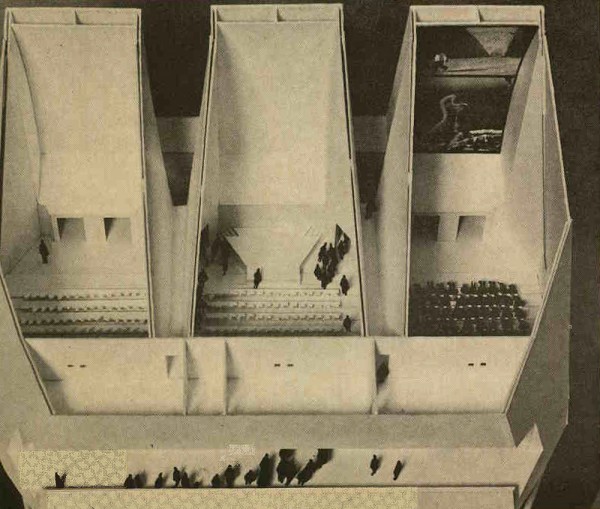
A maquette of the three parallel theaters used to screen The Earth is Man’s Home at Expo 67 in Montreal. Each theatre seated up to 150 viewers per screening.
American Cinematographer (1967). “The Earth is Man’s Home”. American Cinematographer, Special Issue on Expo 67 (August): p. 570.
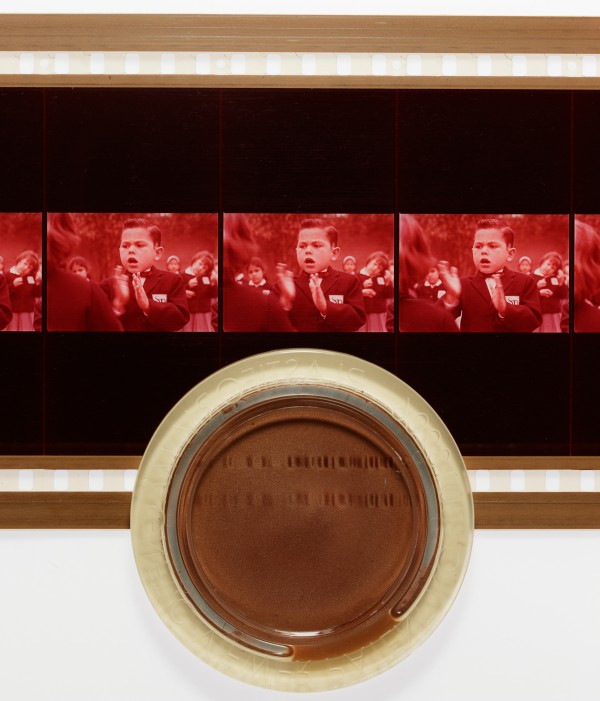
70mm print of Earth is Man’s Home (1967) with two of the three audio tracks visualized with a magnetic tape viewer. The third track is positioned on the magnetic strip on the opposite edge of the frame, between the frame and sprocket holes.
La Cinémathèque québécoise, Montréal, Canada. Photograph by Stéphanie Côté.
References
American Cinematographer (1967). “The Earth is Man’s Home”. American Cinematographer (Special Issue on Expo 67: Aug.): p. 570.
Anon. (1969). “Credits and Processes at Expo—A Summary”. Journal of the University Film Association , 21:1: pp. 13, 30. http://www.jstor.org/stable/20687027.
Bergh, Nicholas (2017). “Audio Transfer Report”. Internal correspondence. Burbank, CA: Endpoint Audio Labs.
Chaparos, Nick (1967). “Producing and Filming The Earth is Man’s Home”. American Cinematographer, Special Issue on Expo 67 (Aug.): pp. 571, 587–90.
Churchill, Peg (1967). “City Man Designs Expo Exhibit”. Schenectady Gazette (May 25), p. 23.
Lewin, Frank (1968). “Man and His Sound – Expo 67”. Journal of the SMPTE, 77: 3 (Mar.): pp. 194–209.
Love, Cecil (1967). “Optical Effects Printing for The Earths is Man’s Home”. 1967. American Cinematographer,Special Issue on Expo 67 (Aug.): pp. 590, 593.
Linwood Dunn Collection, Margaret Herrick Library, Academy of Motion Picture Arts and Sciences, Hollywood, CA.
Patents
Compare
Related entries
Authors
Stéphanie Côté has worked at the Cinémathèque québécoise since 1999, mainly as a film archivist, but now as restoration projects manager. She took part in the reconstruction of five Expo 67 films, including Earth is Man's Home, collaborated on their presentation in galleries, and gave two lectures on the subject at the AMIA conference (2017 and 2018). She has always been passionate about unconventional forms of cinema, from her participation in the GRAFICS research project on the emergence of montage (pre-1900) during her film studies, to her recent training at MoMA’s Caring for Artists’ Films Workshop, in 2019.
Chip Limeburner is a doctoral student at Concordia University, Montreal, Canada, where their research turns on questions of tech integration in themed entertainment. While their dissertation work is focused on nighttime spectaculars, through membership to both the Technoculture, Arts, and Games (TAG) Lab, and the Centre for Sensory Studies, they are also engaged with design research on interactive embedded tech, multisensory cinema and stuntronics. A scenic designer and creative technologist by professional experience, they not only maintain ties to the Themed Experience and Attractions Academic Society (TEAAS), but also the Themed Entertainment Association (TEA) and International Association of Amusement Parks and Attractions (IAAPA) as well.
Monika Kin Gagnon is professor of Communication Studies at Concordia University, Montreal, Canada. She is author, editor and co-editor of numerous essays and books, including Reimagining Cinema: Film at Expo 67 (2014), co-edited with Janine Marchessault; and In Search of Expo 67 (2021) based on a 2017 exhibition of 22 artists co-curated with Lesley Johnstone, which included a programmed section of restored and simulated expanded cinema from Expo 67. She is currently a member of the research group, Locating Transnational Collaborations in the Early History of Imax Films and Architectures (1970–1990).
The authors thank Nicholas Bergh of Endpoint Audio Labs, Inc. and Paul Gordon, senior film conservator, Library and Archives Canada for their insights.
Côté, Stéphanie , Chip Limeburner & Monika Kin Gagnon (2025). “The Earth is Man's Home”. In James Layton (ed.), Film Atlas. www.filmatlas.com. Brussels: International Federation of Film Archives / Rochester, NY: George Eastman Museum.


